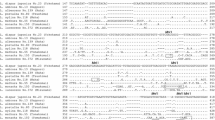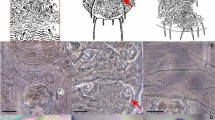Abstract
A polymerase chain reaction-restriction fragment length polymorphism (PCR–RFLP)-based method for species identification was applied to seven Japanese Lymantria species, including four Asian gypsy moth (AGM) species. We sequenced the partial end of the cytochrome c oxidase I (COI) gene, tRNA leucine, COII gene, and partial end of the tRNA lysine in mitochondrial DNA (mtDNA) for one individual of each of the seven species. We analyzed the recognition sites of three restriction endonucleases and constructed a scheme for Lymantria species identification using PCR–RFLP. We then applied the scheme to 291 individuals from 45 populations of seven species. We found that all seven species were correctly identified using PCR–RFLP. These results suggest that PCR–RFLP is useful for identifying Japanese Lymantria species, which may be detected at Japanese ports.




Similar content being viewed by others
References
Baranchikov YN (1989) Ecological basis of the evolution of host relationships in Eurasian gypsy moth populations. In: Wallner WE, McManus KA (eds) Proceedings, Lymantriidae: a comparison of features of new and old world tussock moths. United States Department of Agriculture, Forest Service, Northeastern Forest Experiment Station, Broomall, Pennsylvania, pp 319–338
Bogdanowicz SM, Wallner WE, Bell J, ODell TM, Harrison RG (1993) Asian gypsy moths (Lepidoptera: Lymantriidae) in North America: evidence from molecular data. Ann Entomol Soc Am 86:710–715
Bogdanowicz SM, Schaefer PW, Harrison RG (2000) Mitochondrial DNA variation among worldwide populations of gypsy moths, Lymantria dispar. Mol Phylogenet Evol 15:487–495
Clary DO, Wolstenholme DR (1985) The mitochondrial DNA molecule of Drosophila yakuba: nucleotide sequence, gene organization, and genetic code. J Mol Evol 22:252–271
Harrison RG, ODell TM (1989) Mitochondrial DNA as a tracer of gypsy moth origins. In: Wallner WE, McManus KA (eds) Proceedings, Lymantriidae: a comparison of features of new and old world tussock moths. United States Department of Agriculture, Forest Service, Northeastern Forest Experiment Station, Broomall, Pennsylvania, pp 265–273
Higashiura Y, Yamaguchi H, Ishihara M, Ono N, Tsukagoshi H, Yokobori S, Tokishita S, Yamagata H, Fukatsu T (2011) Male death resulting from hybridization between subspecies of the gypsy moth, Lymantria dispar. Heredity 106:603–613
Inoue H (1982) Lymantriidae. In: Inoue H, Sugi S, Kuroko H, Moriuti S, Kawabe A (eds) Moths of Japan, vol. 1. Text. Kodansha, Tokyo, pp 628–638 (in Japanese)
Iwaizumi R, Arakawa K (2010) Report on female flight activity of the Asian gypsy moth, Lymantria dispar (Lepidoptera: Lymantriidae) and flight suppression with a yellow light source in Japan. Res Bull Pl Prot Jpn 46:9–15
Keena MA (1996) Comparison of the hatch of Lymantria dispar (Lepidoptera: Lymantriidae) eggs from Russia and the United States after exposure to different temperatures and durations of low temperature. Ann Entomol Soc Am 89:564–572
Keena MA, Côté M-J, Grinberg PS, Wallner WE (2008) World distribution of female flight and genetic variation in Lymantria dispar (Lepidoptera: Lymantriidae). Environ Entomol 37:636–649
Kishida Y (2011) Lymantriidae. In: KishidaY (ed) The standard of moths in Japan 2. Gakken Education Publishing, Tokyo, pp 139–147 (in Japanese)
Kox LFF, van den Beld HE, Lindhout BI, de Goffau LJW (2005) Identification of economically important Liriomyza species by PCR-RFLP analysis. EPPO Bull 35:79–85
Larkin MA, Blackshields G, Brown NP, Chenna R, McGettigan PA, McWilliam H, Valentin F, Wallace IM, Wilm A, Lopez R, Thompson JD, Gibson TJ, Higgins DG (2007) Clustal W and Clustal X version 2.0. Bioinformatics 23:2947–2948
Lee M-L, Lee M-H (1997) Amplified mitochondrial DNA identify four species of Tetranychus mites (Acarina: Tetranychidae) in Korea. Korean J Appl Entomol 36:30–36
McKern JA, Szalanski AL (2007) Molecular diagnostics of economically important clearwing moths (Lepidoptera: Sesiidae). Florida Entomol 90:475–479
Muraji M, Nakahara S (2002) Discrimination among pest species of Bactrocera (Diptera: Tephritidae) based on PCR-RFLP of the mitochondrial DNA. Appl Entomol Zool 37:437–446
Myers JH, Simberloff D, Kuris AM, Carey JR (2000) Eradication revisited: dealing with exotic species. Trends Ecol Evol 15:316–320
North American Plant Protection Organization (NAPPO) (2009) NAPPO regional standards for phytosanitary measures (RSPM) No. 33, Guidelines for regulating the movement of ships and cargo from areas infested with the Asian gypsy moth. The Secretariat of the North American Plant Protection Organization, Ottawa, Ontario
Pogue MG, Schaefer PW (2007) A review of selected species of Lymantria Hübner [1819] including three new species (Lepidoptera: Noctuidae: Lymantriinae) from subtropical and temperate regions of Asia, some potentially invasive to North America. United States Department of Agriculture Forest Service, Forest Health Technology Enterprise Team, Morgantown, West Virginia
Schaefer PW, Weseloh RM, Sun X, Wallner WE, Yan J (1984) Gypsy moth, Lymantria (=Ocneria) dispar (L.) (Lepidoptera: Lymantriidae), in the People’s Republic of China. Environ Entomol 13:1535–1541
Schintlmeister A (2004) The taxonomy of the genus Lymantria Hübner, [1819] (Lepidoptera: Lymantriidae). Quadrifina 7:1–248
Szalanski AL, Austin JW, Owens CB (2003) Identification of Reticulitermes spp. (Isoptera: Reticulitermatidae) from south central United States by PCR-RFLP. J Econ Entomol 96:1514–1519
Wallner WE, Humble LM, Levin RE, Baranchikov YN, Cardé RT (1995) Response of adult Lymantriid moths to illumination devices in the Russian far east. J Econ Entomol 88:337–342
Yokochi H (2007) Current situations and issues at the export quarantine inspection consultation. Plant Prot 61:451–456 (in Japanese)
Acknowledgments
We thank Prof. Y. Higashiura, Tokyo University of Pharmacy and Life Sciences, Dr. S. Yoshimatsu, National Institute for Agro-Environmental Sciences, and Mr. K. Arakawa, Mr. M. Satoh, and Dr. S. Takano, Yokohama Plant Protection Station who provided useful suggestions. We also thank Dr. K. Matsumoto, Tohoku Research Center, Forestry and Forest Products Research Institute who provided specimens of L. mathura collected at Morioka city, Iwate Prefecture. The remaining Lymantria specimens analyzed in the present study were collected by plant quarantine officers in several Plant Protection Stations.
Author information
Authors and Affiliations
Corresponding author
Electronic supplementary material
Below is the link to the electronic supplementary material.
Rights and permissions
About this article
Cite this article
Arimoto, M., Iwaizumi, R. Identification of Japanese Lymantria species (Lepidoptera: Lymantriidae) based on PCR–RFLP analysis of mitochondrial DNA. Appl Entomol Zool 49, 159–169 (2014). https://doi.org/10.1007/s13355-013-0235-x
Received:
Accepted:
Published:
Issue Date:
DOI: https://doi.org/10.1007/s13355-013-0235-x




